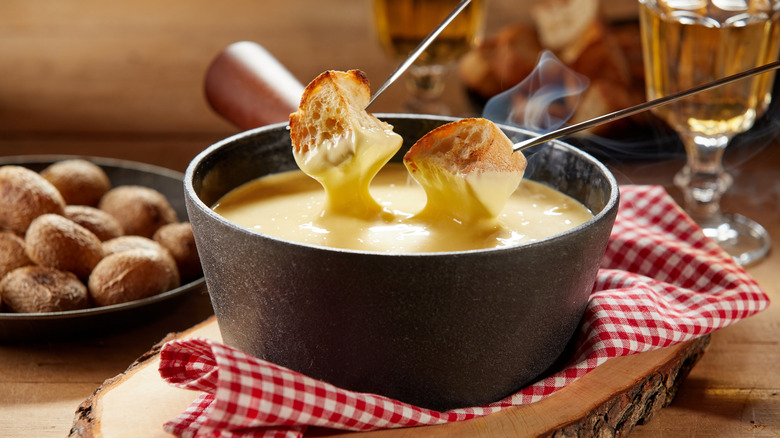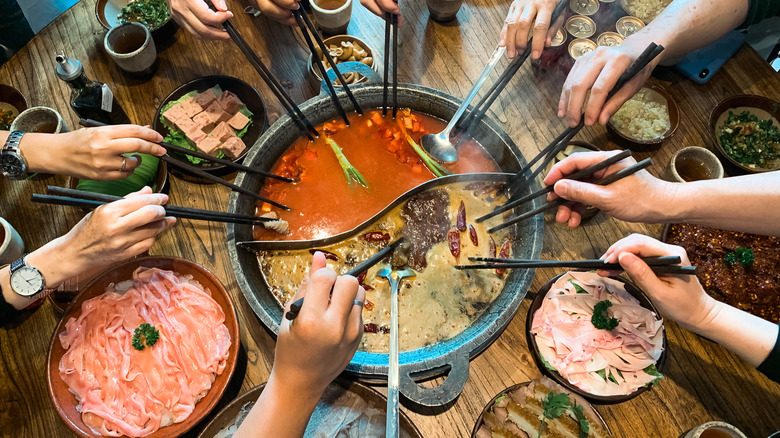Is There A Real Difference Between Fondue And Hot Pot?
There's nothing like gathering around a table of friends and good food armed with a sharp stick and an empty stomach. This scenario describes two hugely popular meals: fondue and hot pot. Are they one and the same? Both dishes are shared meals that involve cooking food using metal spears or some sort of utensil along with a heated vessel of liquid. So yes, the basic logistics of both fondue and hot pot are similar.
However, many cultures worldwide have some kind of dish that involves cooking meat or veggies in hot bowls of broth, and there are obviously a few key differences that make confusing these two soup-adjacent meals impossible. For instance, you're not likely to be invited out to "Sichuan fondue" anytime soon, nor will the expression "Gruyère hot pot" ever cross your lips.
To start off the debate, consider what exactly constitutes fondue. Merriam-Webster offers one definition of fondue as "a dish that consists of small pieces of food (such as meat or fruit) cooked in or dipped into a hot liquid." This vague description offers a lot of leeway, and you might be surprised to find out just how far it can stretch.
Fondue can be sweet or savory
Fondue, which has been Switzerland's national dish since the 1930s, is generally said to come from the Alps on the French or Swiss side, depending on who you ask (via BBC). It manifests as a bowl of melted cheese and wine, into which participants jab long metal spears with bread cubes and other toppings and submerge them in cheesy goodness.
After all, the name fondue literally comes from the French word "fondre," which means to melt, per Paste. According to Food & Wine, it is typically made with common Swiss cheeses like Gruyère, Emmentaler, Vacherin Fribougeois, Appenzeller, and Raclette and served with accouterments like pearl onions, cornichons, salami, and bread.
But cheese isn't the only type of fondue. For those with a sweet tooth, chocolate fondue is a party favorite that is served with fruit. And then there is fleischfondue, a German classic that involves cooking individual pieces of meat in a hot vat of either oil or broth and serving them with vegetables, various dips, and spices like chimichurri or basil pesto, as noted by Earth Food and Fire.
Hot pot uses broth as its main dipping liquid
According to Thrillist, hot pot is a form of communal dining with variations across Japan, Korea, Taiwan, Vietnam, and different regions of China, originally spread throughout East Asia by way of Mongolia. Fans of the DIY-style soup crowd around the hot pot, which is often split in half to allow for two different types of broth in a yuanyang (via New York Times). Cooked ingredients include an array of beef, chicken, seafood, tofu, rice cakes, noodles, fish cakes, dumplings, and various vegetables.
Flavors can vary dramatically across different styles, and it's customary for each participant to set aside a personal dipping dish, which they can fill at their preference with vinegar, soy sauce, sesame paste, chili oil, crushed peanuts, garlic, and more (per Hot Pot Ambassador).
When it comes to comparing hot pot and fondue, this is what it boils down to. The Spruce Eats shares that the definition of fondue is wide enough to cover hot pot as well, though the distinct difference in the dipping liquids used makes this a very fine line.
Hot pot typically sticks to broth for its cooking liquid, while fondue can take on different forms like cheese and chocolate aside from a savory broth. Saying that hot pot could technically be considered a type of fondue is true to a point — but one look at both and you'll know without a doubt they're unique from each other.


